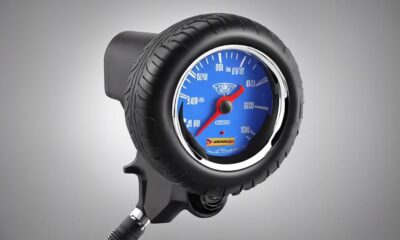Beginners Guides
What Temperature for Pancakes on Griddle
2025

When making pancakes on a griddle, achieving the perfect golden-brown color and fluffy texture is all about getting the temperature just right.
But how do we know what the ideal temperature is for our pancake batter? It's a question that many of us have pondered while standing over a sizzling griddle, spatula in hand.
Well, the answer lies in understanding the science behind pancake cooking and the importance of getting the griddle temperature just right.
Stick with us as we explore the nuances of griddle temperature for pancakes and uncover the secrets to achieving pancake perfection.
Key Takeaways
- Correct griddle temperature ensures even cooking and desired texture
- Ideal temperature for pancake batter is around 375°F (190°C)
- Adjusting temperature for different pancake types ensures desired texture and appearance
- Regularly monitoring and adjusting the griddle's thermostat maintains consistent temperature on the griddle
Importance of Griddle Temperature
Maintaining the correct griddle temperature when making pancakes is crucial due to its impact on heat distribution and cooking time. Achieving the ideal temperature ensures that the pancake batter cooks evenly, resulting in a golden brown color and a fluffy texture. When the griddle is too hot, the outer layer of the pancake may char before the inside is fully cooked, leading to an unappealing taste and texture. Conversely, if the griddle is too cool, the pancake will take longer to cook, potentially resulting in a dry and tough end product.
Proper heat distribution is essential for consistent pancake quality. A well-heated griddle allows the batter to spread evenly, creating uniform shapes and sizes. This is particularly important for professional chefs and cooking enthusiasts who seek mastery in their culinary endeavors. Additionally, maintaining the correct griddle temperature significantly affects cooking time. When the griddle is at the right temperature, pancakes cook in a timely manner, ensuring efficiency and a steady output.
Therefore, controlling the griddle temperature is paramount for achieving perfect pancakes with a delightful taste and texture.
Optimal Temperature for Pancake Batter

Achieving the ideal temperature for pancake batter is crucial for ensuring even cooking and a desirable texture. The optimal temperature for pancake batter is around 375°F (190°C). This temperature allows the batter to cook evenly without burning on the outside while remaining raw inside. When the griddle is too hot, the batter will spread too quickly, resulting in thin, overcooked pancakes. On the other hand, if the griddle is too cool, the batter won't spread properly, leading to thick, undercooked pancakes.
Batter consistency plays a significant role in the cooking process. A slightly thick, but pourable consistency is optimal for pancake batter. If the batter is too thick, the pancakes will turn out dense and doughy. Conversely, if the batter is too runny, the pancakes will spread too much and become thin and flat.
The cooking time for each pancake is typically 2-3 minutes per side when the griddle is at the recommended temperature. This allows for the perfect golden-brown color and ensures that the pancakes are cooked all the way through without being too dry.
Adjusting Temperature for Different Pancake Types
For different types of pancakes, it's essential to adjust the griddle temperature to achieve the desired texture and appearance while maintaining even cooking.
When making fluffy pancakes, it's best to set the griddle to a medium-low temperature, around 325°F (165°C). This allows the batter to rise and form air pockets, resulting in a light and airy texture. Cook these pancakes for approximately 2-3 minutes per side until golden brown.
For thinner crepes or delicate lace pancakes, a higher temperature is needed to ensure a quick and even cooking process without drying them out. Set the griddle to medium-high, around 375°F (190°C), and pour a thin layer of batter onto the heated surface. Due to the higher heat, these pancakes only need around 1-2 minutes of cooking per side to achieve a slightly crispy texture while remaining tender.
When preparing denser pancake varieties, such as whole grain or oatmeal pancakes, a lower temperature, similar to that used for fluffy pancakes, is suitable. The slower cooking process allows the batter to cook through without burning the exterior, resulting in a moist and tender pancake. Cook these pancakes for approximately 3-4 minutes per side until they're fully cooked and golden brown.
Maintaining Consistent Temperature on the Griddle
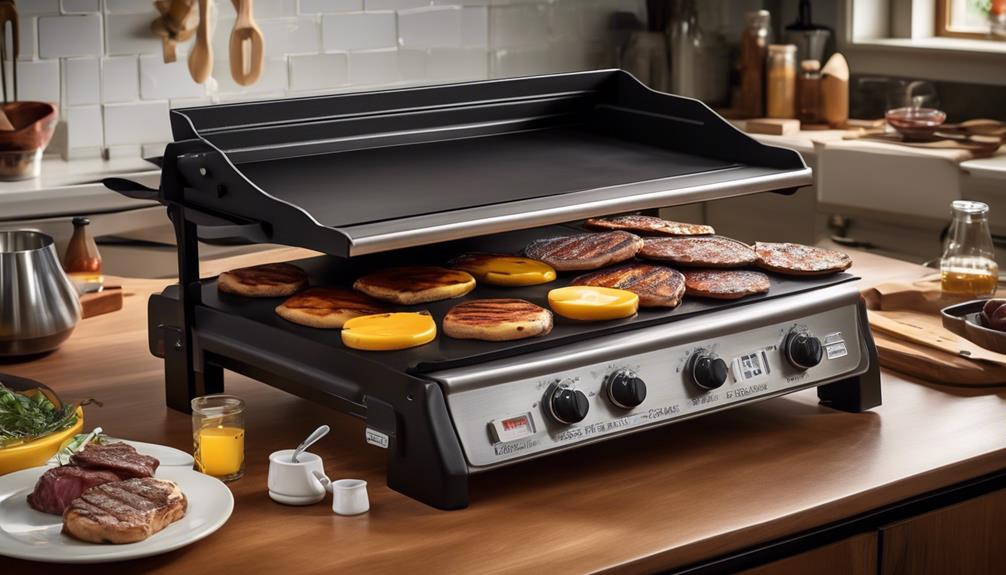
To ensure consistent temperature on the griddle, it's essential to monitor and adjust the heat settings as needed to maintain the desired cooking environment for different types of pancakes. Heat control and temperature regulation are critical aspects of achieving the perfect pancake.
Here are key considerations for maintaining a consistent griddle temperature:
- Preheating: Allow the griddle to preheat thoroughly to the desired temperature before pouring the pancake batter. This ensures an even cooking surface and consistent results.
- Thermostat Adjustment: Regularly monitor the griddle's thermostat and make small adjustments as needed to maintain the desired temperature. This helps prevent undercooked or overcooked pancakes.
- Heat Distribution: Pay attention to the heat distribution across the griddle surface. Adjust the heat settings to ensure even cooking, preventing hot spots that can lead to unevenly cooked pancakes.
- Cooking Environment: Factors such as ambient temperature and humidity can affect the griddle's performance. Be mindful of these environmental variables and make adjustments to the heat settings as necessary.
- Consistency: Continuously monitor the griddle temperature throughout the cooking process to maintain a consistent environment for producing perfectly cooked pancakes.
Maintaining consistent temperature on the griddle is crucial for achieving mastery in pancake making. With precise heat control and diligent temperature regulation, you can elevate your pancake game to perfection.
Tips for Testing Griddle Temperature
Monitoring the griddle's temperature accurately contributes to maintaining consistent heat levels, which is crucial in achieving the perfect pancake texture and flavor. To ensure the griddle is at the optimal temperature for pancake perfection, there are various testing techniques that can be employed. Here are some tips for testing griddle temperature:
| Testing Technique | Description | Temperature Range |
|---|---|---|
| Water Droplets Test | Sprinkle a few drops of water onto the griddle. If the water sizzles and evaporates almost immediately, the griddle is around 375°F – 400°F. | 375°F – 400°F |
| Flour Test | Sprinkle a pinch of flour onto the griddle. If the flour immediately turns golden brown in 60 seconds, the griddle is at approximately 350°F – 375°F. | 350°F – 375°F |
| Time Test | Preheat the griddle for 10 minutes and then place a pancake on it. If the pancake cooks evenly in 2-3 minutes without burning, the griddle is at the ideal 375°F – 400°F temperature. | 375°F – 400°F |
These testing techniques ensure temperature accuracy, allowing for the perfect pancake every time.
Frequently Asked Questions
Can I Use a Griddle on an Electric Stove, or Is It Better to Use a Gas Stove?
We've found that an electric stove works just as well as a gas stove for using a griddle.
Electric stoves offer precise temperature control, making it easier to maintain a consistent heat level for cooking pancakes.
Gas stoves also work fine, but they might require a bit more attention to maintain the desired temperature.
Ultimately, both electric and gas stoves can yield delicious pancakes when using a griddle.
Is There a Specific Temperature Range for Making Gluten-Free Pancakes on a Griddle?
We've found that for gluten-free pancake recipes, a griddle set to medium heat is like finding the sweet spot for a perfectly toasted marshmallow. This temperature allows the pancakes to cook through evenly without burning the outside.
It's crucial to let the griddle preheat and to lightly grease it before cooking. Some experimentation with cooking techniques may be needed to find the ideal heat level for your specific recipe.
How Does Altitude Affect Griddle Temperature and Cooking Time for Pancakes?
At higher altitudes, the impact on griddle temperature and cooking time for pancakes is significant. The lower air pressure causes water to evaporate faster, which can lead to drier batter and quicker cooking. To adjust, increase the griddle temperature slightly and decrease the cooking time.
This balances the effects of altitude and ensures your pancakes turn out just right. It's crucial to make these cooking adjustments for optimal results at different altitudes.
Are There Any Special Considerations for Using a Cast Iron Griddle Versus a Non-Stick Griddle?
When using a cast iron griddle, it's essential to maintain its seasoning by regularly seasoning it with a thin layer of oil. This not only prevents rust but also creates a naturally non-stick surface.
Non-stick griddles, however, require cautious use of utensils to avoid scratching the coating.
Both options have their benefits, but proper care for cast iron is crucial for longevity and performance.
What Are the Best Practices for Preheating a Griddle to the Optimal Temperature for Pancakes?
Preheating the griddle is crucial for perfect pancakes. We aim for a medium heat to ensure even cooking without burning. Once the griddle reaches the optimal temperature, we use a ladle to pour the batter onto the surface.
The consistency of the batter is crucial for successful pancake flipping. We wait for bubbles to appear on the surface before flipping, ensuring a fluffy and golden-brown outcome.
What is the Ideal Temperature for Cooking Pancakes on a Griddle?
The ideal griddle temperature for cooking pancakes is around 375°F. This ensures that the pancakes cook evenly and develop a golden brown color. Cooking pancakes at the right temperature is essential to achieving the perfect texture and flavor. Keeping the griddle at the ideal temperature is key to making delicious pancakes.
Conclusion
In conclusion, maintaining the right temperature on the griddle is crucial for perfect pancakes.
Did you know that the ideal temperature for cooking pancakes is around 375°F? This ensures a golden brown color and fluffy texture.
By adjusting the temperature for different types of pancakes and testing the griddle's heat, you can achieve consistent and delicious results every time.
Mastering the art of griddle temperature will elevate your pancake game to a whole new level.
- About the Author
- Latest Posts
Introducing Ron, the home decor aficionado at ByRetreat, whose passion for creating beautiful and inviting spaces is at the heart of his work. With his deep knowledge of home decor and his innate sense of style, Ron brings a wealth of expertise and a keen eye for detail to the ByRetreat team.
Ron’s love for home decor goes beyond aesthetics; he understands that our surroundings play a significant role in our overall well-being and productivity. With this in mind, Ron is dedicated to transforming remote workspaces into havens of comfort, functionality, and beauty.
Beginners Guides
The Best Time to Go on a Cruise for Perfect Weather
Sail through the maze of climate patterns to uncover the best times for perfect weather on a cruise, ensuring a memorable voyage awaits.
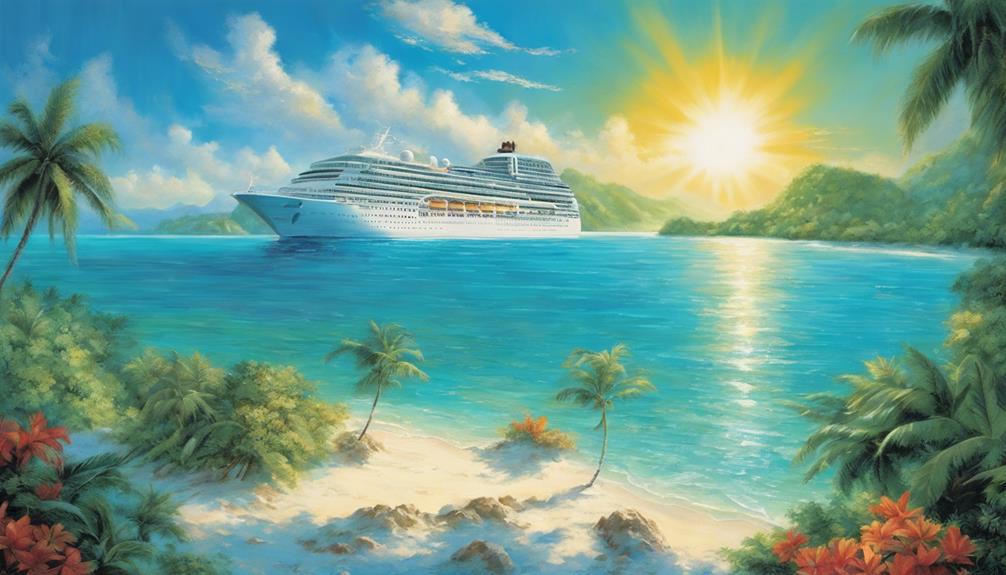
When it comes to choosing the best time to go on a cruise for perfect weather, it's like steering a maze of climate patterns to find that golden ticket. But fear not, as we have the compass to guide you in the right direction.
Understanding the seasonal nuances can make all the difference between a sun-kissed voyage and a rainy retreat. So, grab your sunscreen and pack your bags as we uncover the best times to set sail for idyllic weather conditions that will make your cruise a memorable experience.
Key Takeaways
- Caribbean cruises: December to mid-April for best weather conditions
- Alaskan cruises: Late June to mid-July for breathtaking landscapes
- Mediterranean cruises: April-May & September-October for ideal weather
- Hawaii cruises: Summer and fall months for dry weather and sunny skies
Ideal Months for Caribbean Cruises
For ideal weather conditions and a pleasant cruising experience in the Caribbean, consider booking your voyage between December and mid-April. During this period, the Caribbean boasts the best weather for cruises, with dry conditions and sunny skies prevailing. This stretch offers a fantastic opportunity to soak up the sun, enjoy water activities, and explore the stunning destinations in the region without the worry of rainstorms or excessive humidity.
Late summer into fall presents the cheapest time for Caribbean cruises, making it an excellent choice for budget-conscious travelers looking to experience the beauty of the Caribbean without breaking the bank. By opting for a cruise during this period, you can take advantage of lower prices and fewer crowds while still enjoying the warm waters and picturesque landscapes the Caribbean is known for.
Avoiding the peak season from December to April is advisable for those seeking a more peaceful and wallet-friendly experience. Sailing in late June through August allows travelers to steer clear of the crowds, particularly families on vacation during school breaks, making for a more relaxed and intimate cruise experience.
Optimal Weather for Alaskan Cruises

To maximize your Alaskan cruise experience, targeting late June through mid-July guarantees ideal weather conditions for enjoying the breathtaking landscapes and wildlife sightings in the region. During mid-July, you can witness the spectacular salmon run season, where various wildlife, including bears and bald eagles, gather along the rivers for this perfect phenomenon.
Late August to mid-September is another excellent window for Alaskan cruises, offering pleasant weather and often lower prices as it marks the end of the peak season. If your focus is on spotting whales, August is the prime time for your cruise, as these majestic creatures are commonly seen during this period.
For those seeking a balance between affordability and decent weather, mid-May to early June also presents a good opportunity to explore Alaska on a cruise. Keep these ideal weather periods in mind when planning your Alaskan adventure for an unforgettable experience.
Perfect Seasons for Mediterranean Cruises
April-May and September-October stand out as the prime seasons for Mediterranean cruises, offering ideal weather conditions and fewer crowds for a delightful experience exploring the region. During these shoulder seasons, the Mediterranean boasts milder temperatures and a more relaxed atmosphere compared to the peak tourist season in July and August. Traveling in April or May allows for pleasant sightseeing without the sweltering heat or overwhelming crowds. Likewise, September and October provide a serene setting for cruising with comfortable weather and less tourist congestion.
Additionally, prices for Mediterranean cruises tend to be lower from May to November, making it a cost-effective option for travelers seeking a budget-friendly voyage. Consider booking a Mediterranean cruise in May 2024 with MSC starting at $499/person to enjoy the perfect blend of favorable weather and affordable prices.
- Ideal weather conditions
- Fewer crowds
- Milder temperatures
- Lower prices during shoulder seasons
- Peak tourist season in July and August
Prime Time for Hawaii Cruises
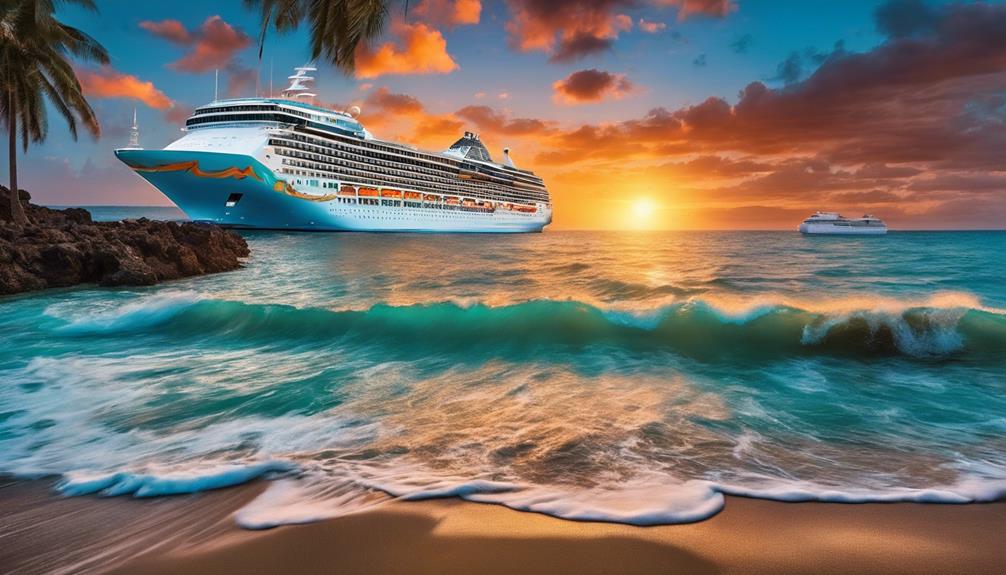
The best time to start on a Hawaii voyage is usually during the summer and fall months when the weather is dry and the skies are sunny. Hawaii cruises are particularly rewarding from mid-September through October, offering ideal conditions for a memorable experience. If you're interested in whale watching, the period from late October through May is perfect for spotting these majestic creatures in their natural habitat. During this time, the weather remains pleasant, with minimal rainfall from August through October, ensuring a smooth sailing experience.
For travelers seeking a cost-effective option, January through March can be a good time to contemplate a Hawaii cruise, although weather conditions may vary slightly. These months often offer competitive pricing and fewer crowds, allowing you to enjoy the beauty of Hawaii at a more relaxed pace. Whether you're into adventure, relaxation, or simply soaking in the stunning scenery, a Hawaii cruise during the summer and fall months promises an unforgettable journey.
Best Weather for Australia & New Zealand Cruises
For those considering voyages beyond Hawaii, exploring the best weather for Australia & New Zealand cruises becomes paramount, especially as these regions offer unique experiences throughout the year. When planning your cruise to Australia and New Zealand, keep in mind the following key points for an enjoyable voyage:
- November to March: This period offers warm temperatures and sunny weather in major ports like Sydney, making it the best time to go on a cruise in Australia & New Zealand.
- Early February to mid-March: Experience the warmest weather in Australia during these months, ensuring a comfortable cruise.
- New Zealand's Climate: With a temperate climate, layering is recommended for cruises throughout the year to stay comfortable.
- Consider Off-Peak Months: October, November, or April can provide discounted fares in Australia outside the peak season, allowing for savings on your cruise.
- Reversed Seasons: Australia and New Zealand have reversed seasons compared to the northern hemisphere, influencing the ideal timing for a cruise in these regions.
Planning your trip around these factors will help you make the most of your cruise experience in Australia and New Zealand.
Conclusion
To guarantee the best time to go on a cruise for perfect weather is essential for a memorable and enjoyable experience. By researching the ideal months for different regions like the Caribbean, Alaska, Mediterranean, Hawaii, Australia, and New Zealand, you can secure smooth sailing and sunny skies.
Don't just take our word for it, investigate the truth of this theory yourself and discover the magic of cruising in ideal weather conditions.
- About the Author
- Latest Posts
Introducing Ron, the home decor aficionado at ByRetreat, whose passion for creating beautiful and inviting spaces is at the heart of his work. With his deep knowledge of home decor and his innate sense of style, Ron brings a wealth of expertise and a keen eye for detail to the ByRetreat team.
Ron’s love for home decor goes beyond aesthetics; he understands that our surroundings play a significant role in our overall well-being and productivity. With this in mind, Ron is dedicated to transforming remote workspaces into havens of comfort, functionality, and beauty.
Beginners Guides
The Best Time to Cruise for Budget-Friendly Deals
Fulfill your wanderlust dreams without draining your wallet by learning the key to scoring budget-friendly cruise deals.
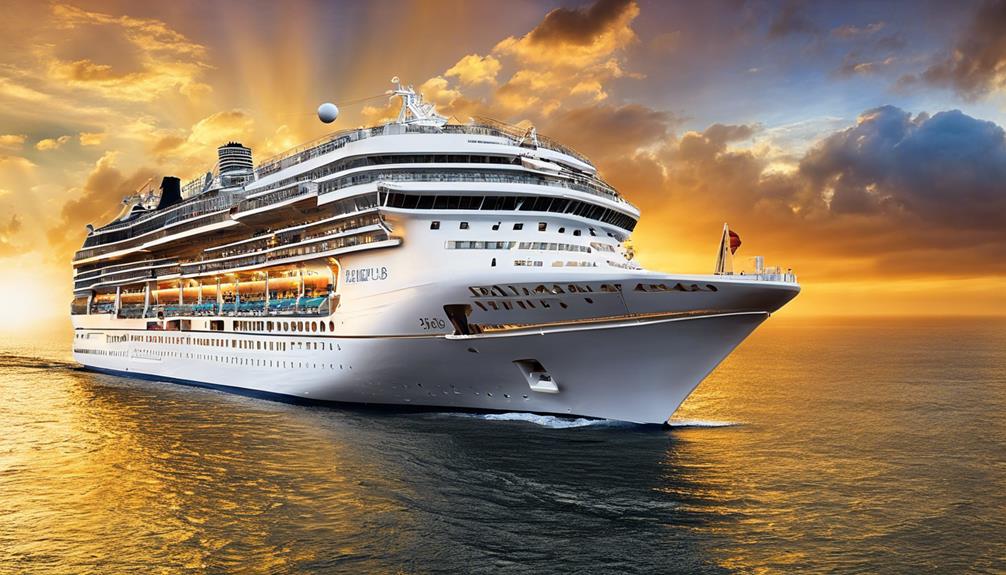
When it comes to finding budget-friendly cruise deals, timing is key. Imagine setting sail on the crystal blue waters of the Caribbean or exploring the stunning glaciers of Alaska without breaking the bank.
There's a specific window of opportunity that savvy cruisers keep an eye on to secure the best rates and save some serious cash. But how do you know when to book your next adventure to make the most of your budget?
Let's uncover the secrets behind scoring the ultimate cruise deals and making your dream vacation a reality.
Key Takeaways
- Booking during wave season in January to March ensures budget-friendly deals.
- Monitoring prices post-booking for drops leads to potential refunds or upgrades.
- Repositioning cruises in spring and fall offer cost-effective options.
- Leveraging loyalty programs maximizes savings for affordable cruising.
Ideal Seasons for Budget-Friendly Cruises
When seeking budget-friendly cruise deals, timing plays an important role in securing the best value for your money. Shoulder seasons such as September, October, and early December present excellent opportunities for travelers looking for cheaper fares. These off-peak times often offer discounted rates and fewer crowds, making it an ideal choice for budget-conscious individuals.
Additionally, booking during wave season in January and February can lead to significant discounts and promotions, maximizing savings on your cruise vacation.
Repositioning cruises during spring and fall are another fantastic option for savvy travelers seeking affordable deals. These cruises often provide cost-effective choices as cruise lines move their ships between different regions.
Avoiding major holidays and school breaks is also key to securing cheaper cruise fares and ensuring a more relaxed cruising experience. Moreover, sailing from Florida during off-peak times can offer a wide range of options and better deals for those looking to save on their cruise adventures.
Strategies for Booking Affordable Cruises
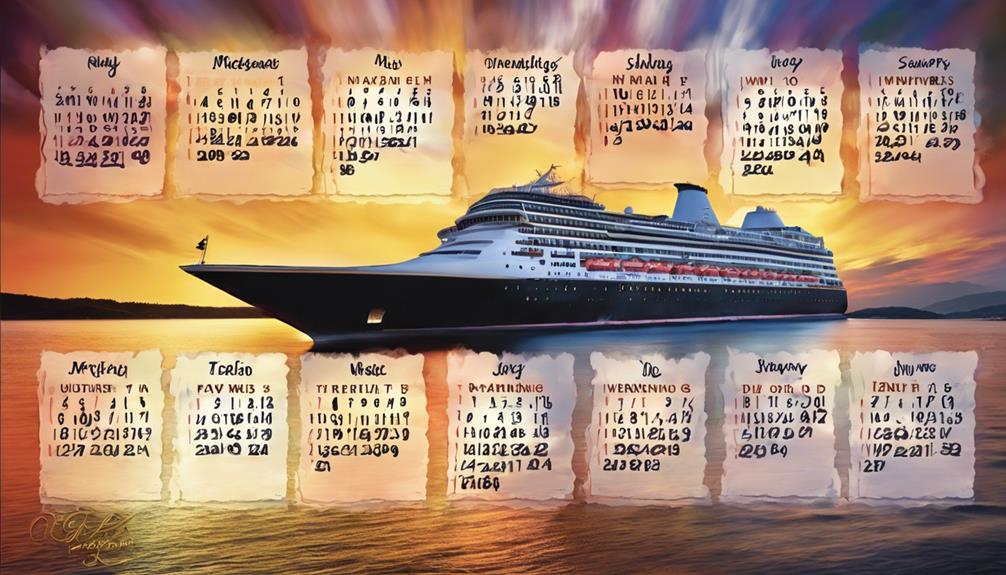
To secure the best deals on cruises, it's important to employ strategic booking approaches that maximize cost savings and value for your vacation. When aiming for budget-friendly cruise deals, consider the following strategies:
- Booking in Advance: Securing your cruise early, especially during wave season from January to March, can lead to lower rates and additional benefits.
- Monitoring Fare Changes: Keep an eye on fluctuating fares and be ready to book when prices drop to secure the best deal.
- Being Flexible with Travel Dates: Flexibility can be key in finding affordable cruise options, as adjusting your travel dates slightly can result in significant savings.
- Considering Repositioning Cruises: Exploring repositioning cruises or sailing during shoulder seasons can offer unique routes and discounted prices.
- Utilizing Loyalty Programs and Off-Peak Times: Take advantage of loyalty programs, monitor price drops, and consider traveling during off-peak times to maximize your savings on cruise vacations.
Best Times to Score Cruise Deals
During wave season from January to March, travelers can capitalize on the best times to secure budget-friendly cruise deals. Booking well in advance is key to snagging the most favorable timing and rates for your cruise.
Additionally, considering repositioning cruises during the spring and fall can offer discounted prices, making them a great option for those seeking budget-friendly deals. It's also advisable to keep an eye out for price drops even after booking, as this could potentially lead to refunds or upgrades for your cruise experience.
Leveraging loyalty programs or memberships can grant you access to exclusive discounts and savings on your upcoming cruise. By being proactive and strategic in your approach to booking and monitoring deals, you can maximize your chances of finding the best cruise deals that align with your budget and preferences.
Timing Tips for Budget-Friendly Cruises
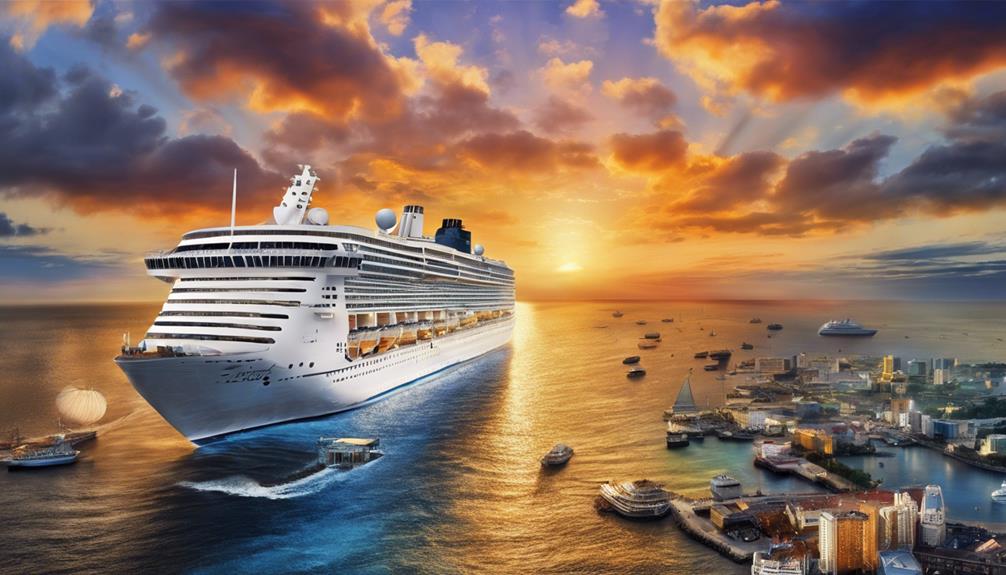
Let's explore practical strategies for maximizing your savings on budget-friendly cruises through strategic timing tips. When aiming to secure the best cruise deals that align with your budget, consider the following insights:
- Booking in Advance: Take advantage of wave season from January to March to lock in lower rates and secure desirable cabin options.
- Monitoring Prices: Keep an eye on price drops even after booking to potentially benefit from refunds or upgrades, enhancing your overall cruise experience.
- Loyalty Programs: Utilize loyalty programs or memberships to access additional discounts and exclusive perks, making your budget-friendly cruise even more cost-effective.
- Nearby Ports: Opt for cruises departing from nearby ports to save on airfare costs, enabling you to allocate more of your budget towards onboard activities and excursions.
- Discounts Galore: Embrace the array of discounts available during wave season and beyond, ensuring that you snag the best possible deal for your budget-friendly cruise adventure.
When to Book for Cruise Savings
Securing cruise savings hinges on strategic timing and proactive booking practices. To find the best deals, consider booking during wave season from January to March when many cruise lines offer enticing discounts.
Booking early not only guarantees better rates but also provides a wider selection of cabin choices. Keep an eye out for fare changes even after booking, as price drops may occur, presenting an opportunity for additional savings.
While waiting for last-minute deals can sometimes lead to the cheapest rates, this approach often comes with limited cabin availability. To stay informed about price fluctuations, utilize tools like the Shipmate app and Cruise Critic for efficient monitoring.
Conclusion
To summarize, cruising during the off-peak season can help us save some serious dough. Booking early during wave season is key to scoring those sweet deals.
So, let's set sail and make some memories without breaking the bank. Remember, early bird gets the worm – or should I say, the cruise discount!
- About the Author
- Latest Posts
Introducing Ron, the home decor aficionado at ByRetreat, whose passion for creating beautiful and inviting spaces is at the heart of his work. With his deep knowledge of home decor and his innate sense of style, Ron brings a wealth of expertise and a keen eye for detail to the ByRetreat team.
Ron’s love for home decor goes beyond aesthetics; he understands that our surroundings play a significant role in our overall well-being and productivity. With this in mind, Ron is dedicated to transforming remote workspaces into havens of comfort, functionality, and beauty.
Beginners Guides
Best Time to Go on an Alaskan Cruise for Wildlife Watching
Get ready to discover the optimal time for wildlife enthusiasts to embark on an Alaskan cruise – the ultimate season for extraordinary encounters awaits!

One could contend that any time of year is fitting for an Alaskan cruise, but if you genuinely want to maximize your wildlife watching opportunities, timing is key.
While many months offer glimpses of nature's wonders, there is a particular period that stands out above the rest.
Join us as we explore the intricacies of the Alaskan wilderness and uncover the secrets of when to set sail on a journey that promises unforgettable encounters with some of the most magnificent creatures on earth.
Key Takeaways
- Prime months for wildlife viewing in Alaska are May, June, and September.
- Peak whale watching season is from mid-June to August.
- Best time for bear spotting is between July and early September.
- Ideal months for bald eagle sightings in southeast Alaska are from May to September.
Prime Months for Wildlife Viewing
During the prime months of May, June, and September, Alaska offers the best conditions for wildlife enthusiasts to observe a diverse array of animals in their natural habitats. June marks the beginning of summer, a time when the landscape comes alive with the sights and sounds of wildlife.
July and August are ideal for witnessing brown bears fishing for salmon and catching glimpses of majestic moose roaming through the wilderness. These months provide ample opportunities for up-close wildlife viewing experiences, especially during the salmon run when bears gather along the rivers to feast.
As the summer changes into September, visitors can look forward to spotting humpback whales during their annual migration, as well as witnessing the spectacular spawning salmon and caribou herds moving across the land. The shoulder seasons offer a unique chance to explore Alaska inside and out, with fewer crowds and mosquitoes, making it an ideal time for wildlife enthusiasts to immerse themselves in the natural beauty of the region.
Peak Whale Watching Season
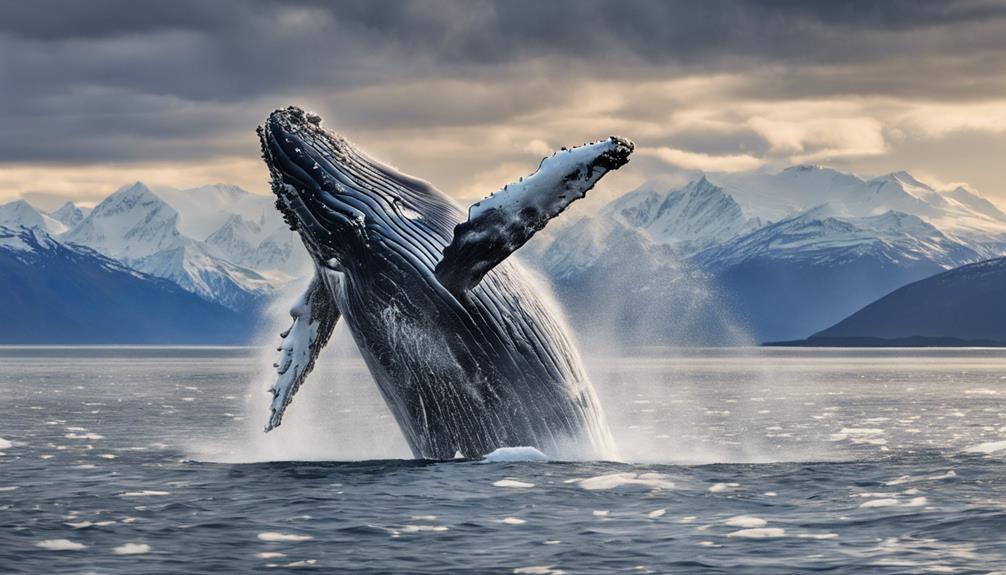
In the peak whale watching season in Alaska, which typically spans from mid-June to August, enthusiasts have the best opportunities to witness humpback whales and other species in their natural habitat. Humpback whales are commonly sighted during the summer months as they feed on small fish and krill.
Killer whales, also known as orcas, are best spotted in May and June near Ketchikan, Juneau, and Seward, hunting for seals and other marine mammals. Grey whales migrate to southern Alaska in late spring, showcasing their impressive breaching behaviors.
Blue whales, the largest animals on Earth, may be seen in July and August, traveling through Alaskan waters in search of food. Whale sightings can vary depending on the specific month of your Alaskan cruise, so choosing the right time within the peak season is important for maximizing wildlife watching opportunities while sailing through these majestic waters.
Best Time for Bear Spotting
Ideally situated between July and early September, the peak time for bear spotting in Alaska coincides with the salmon influx that attracts these magnificent creatures to the creeks and streams of the region. During this period, Grizzly bears can be observed in their natural habitat, offering a thrilling experience for wildlife enthusiasts. Royal Caribbean Cruise Tours in Alaska often include bear viewing excursions, enhancing the opportunity to witness these powerful animals up close. For best bear sightings, consider visiting during the salmon run in July, a time when bears are actively hunting for fish in creeks and streams, particularly in locations like Ketchikan. Alaska's diverse landscapes and ecosystems provide ample opportunities for bear viewing, from observing black bears to encountering majestic brown bears. Whether through guided tours or remote float plane trips, Alaska offers a range of experiences to witness these iconic creatures in their element.
| Best Time for Bear Spotting | |
|---|---|
| July | Salmon run |
| Early September | Grizzly bears |
| Creeks | Streams |
| Ketchikan | Royal Caribbean Cruise Tours |
Ideal Months for Eagle Sightings

The peak months for perfect bald eagle sightings in southeast Alaska are from May to September. During these months, as part of an Alaska cruise, birdwatching enthusiasts can witness the majestic bald eagles in their natural habitat. Southeast Alaska, home to around 30,000 bald eagles, offers ample opportunities for wildlife watching, especially near bodies of water where eagles are commonly spotted.
The Sitka Cultural Discovery excursion is a great way to observe bald eagles up close, as they're frequently seen near streams and bodies of water. With approximately 470 bird species in the region, including the iconic bald eagle, Southeast Alaska provides a diverse birdwatching experience for nature lovers.
Whether soaring through the skies or perched on branches overlooking the water, bald eagles are a common sight throughout the summer months in this pristine Alaskan wilderness. For those seeking unforgettable eagle sightings and a chance to immerse themselves in Alaska's rich wildlife, visiting during the peak months offers an unparalleled birdwatching experience.
Optimal Time for Otter Encounters
Best timing for observing otters in Alaska ranges from early spring through the end of July. During this period, the chances of encountering these enchanting creatures are at their peak. Here are some key points to keep in mind for prime otter encounters during your Alaskan cruise:
- Steller sea lions: While otters are more prevalent during spring and early summer, Steller sea lions can be spotted year-round in Alaska. Keep an eye out for these majestic marine mammals as they often share habitats with otters.
- Streams and creeks: Otters are frequently seen near streams and creeks, making these areas prime locations for wildlife watching. Cruise along these waterways to increase your chances of a memorable otter sighting.
- Wildlife tours: Participating in wildlife tours in Alaska can enhance your otter encounters. These tours often provide opportunities to get up close to Steller sea lions, with otters sometimes making surprise appearances alongside them.
- Sea otters near the ocean: Whether near the ocean or inland water bodies, otters are adaptable creatures that thrive in various environments. Keep a lookout for these playful animals during your Alaskan cruise for a truly immersive wildlife experience.
Conclusion
To sum up, our investigation confirms that the best time to go on an Alaskan cruise for wildlife watching is indeed during the peak season of July.
The abundance of wildlife sightings, perfect weather conditions, and increased chances of spotting bears, whales, eagles, otters, and other fascinating creatures make July the ideal month for an unforgettable Alaskan wildlife experience.
Don't miss out on this prime opportunity to witness the wonders of nature in their natural habitat.
- About the Author
- Latest Posts
Introducing Ron, the home decor aficionado at ByRetreat, whose passion for creating beautiful and inviting spaces is at the heart of his work. With his deep knowledge of home decor and his innate sense of style, Ron brings a wealth of expertise and a keen eye for detail to the ByRetreat team.
Ron’s love for home decor goes beyond aesthetics; he understands that our surroundings play a significant role in our overall well-being and productivity. With this in mind, Ron is dedicated to transforming remote workspaces into havens of comfort, functionality, and beauty.
-

 Decor6 days ago
Decor6 days agoMaximalist Decor Explained: Embrace More Style
-

 Vetted4 weeks ago
Vetted4 weeks ago15 Best Drip Irrigation Systems to Keep Your Garden Thriving
-

 Vetted2 weeks ago
Vetted2 weeks ago15 Best Foot Massagers for Neuropathy to Soothe Your Feet and Relieve Discomfort
-

 Vetted2 weeks ago
Vetted2 weeks ago15 Best Sports Laundry Detergents for Keeping Your Activewear Fresh and Clean
-

 Vetted3 weeks ago
Vetted3 weeks ago15 Best Tall Toilets for Seniors That Combine Comfort and Safety
-

 Vetted3 weeks ago
Vetted3 weeks ago15 Best Dish Scrubbers to Keep Your Kitchen Sparkling Clean
-

 Decor3 weeks ago
Decor3 weeks agoWhat Is Eclectic Home Decor
-

 Vetted3 days ago
Vetted3 days ago15 Best Organic Pest Control Solutions for a Naturally Pest-Free Home












